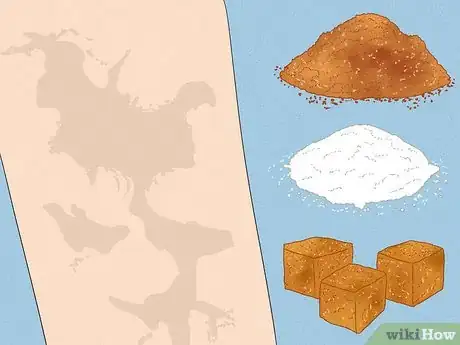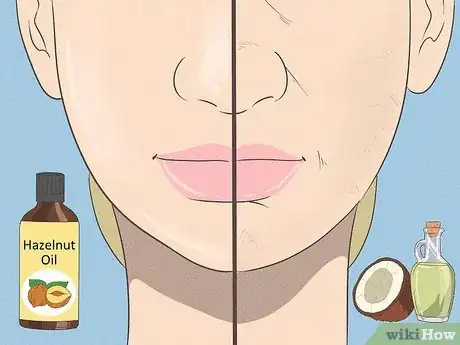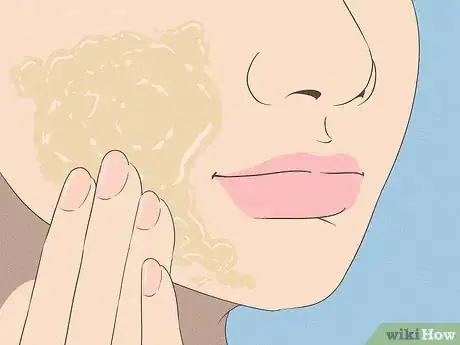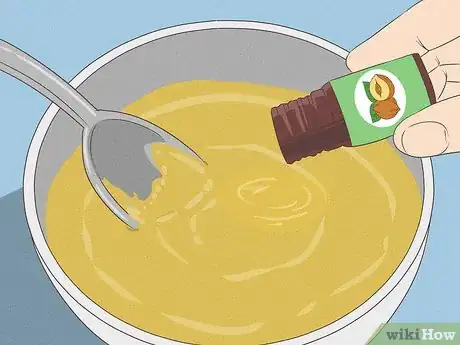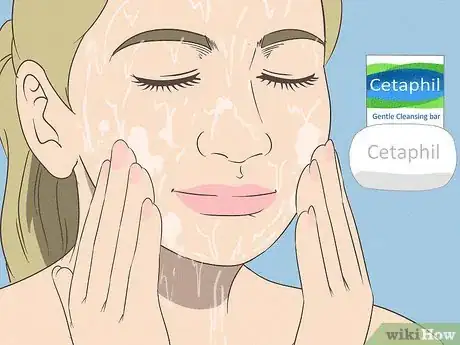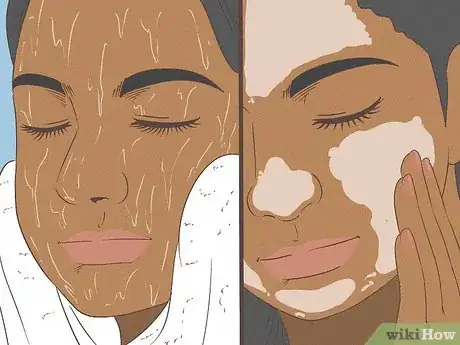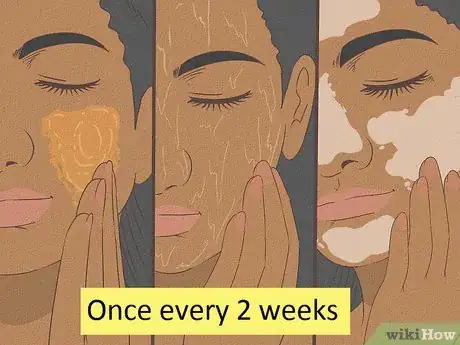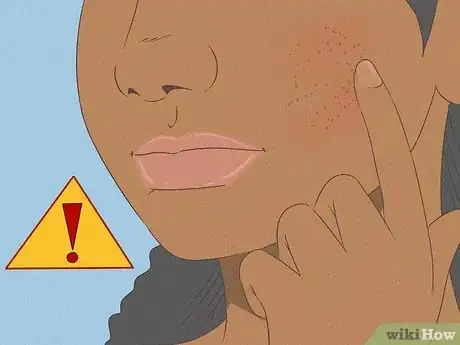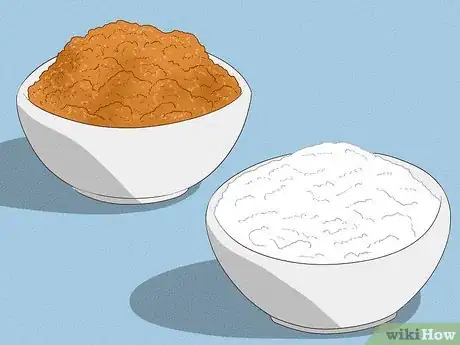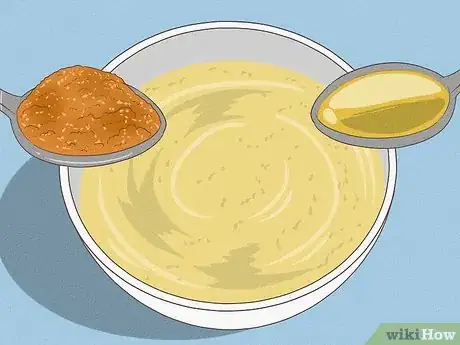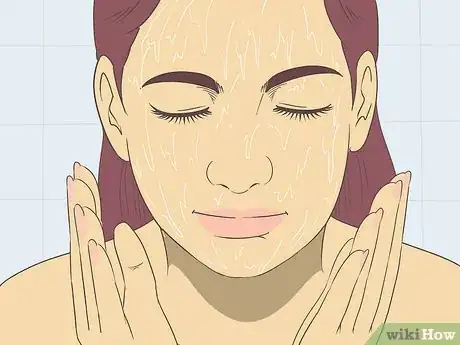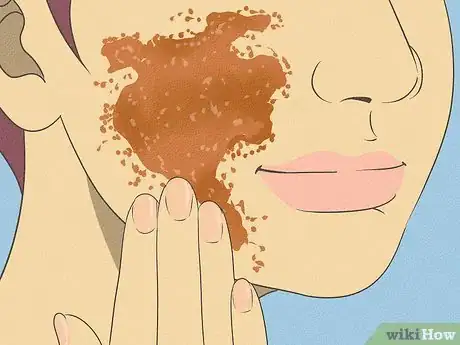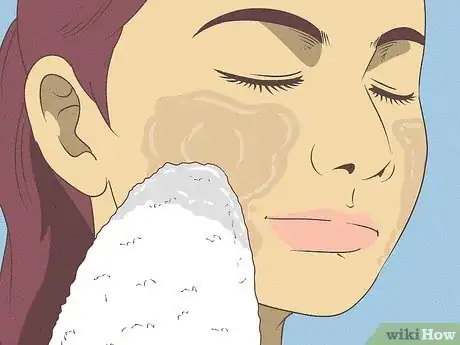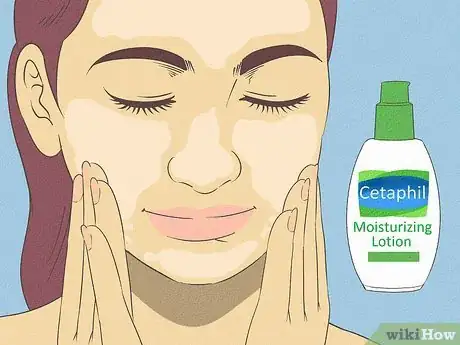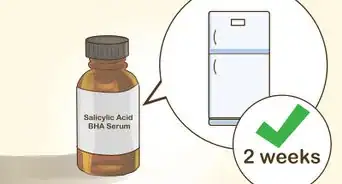This article was co-authored by Barbie Ritzman. Barbie Ritzman is a Beauty Specialist, Influencer, and the Owner of Barbie’s Beauty Bits. With over 10 years of experience in the beauty industry, she specializes in skincare and aesthetics. Barbie studied marketing at Tidewater Community College and holds a Certificate from the Media Buying Academy. For her work, she’s won Beauty Influencer of the Year - The USA and was featured in “The Allure 50,” which includes the year’s 50 most influential people in the beauty industry.
There are 10 references cited in this article, which can be found at the bottom of the page.
wikiHow marks an article as reader-approved once it receives enough positive feedback. In this case, 100% of readers who voted found the article helpful, earning it our reader-approved status.
This article has been viewed 963,374 times.
Sugar particles can scrape away dead skin with a relatively gentle touch. Sugar even contains a little glycolic acid, which keeps skin smooth and fights scaling. It's not a miracle cure for all skin problems, but it's hard to beat on price and skin safety. Keep in mind that any scrub can cause damage when overused.
Steps
Scrubbing Your Body
-
1Start with brown, white, or raw sugar. Raw sugar makes a powerful body scrub, great for feet and extra-rough skin. Brown sugar has smaller grains and plenty of liquid, making it the most gentle option. Granulated white sugar falls somewhere in between: it has the same size grains as brown sugar, but none of the liquid molasses.
- Before you begin, be aware that the scrub can cause temporary blotchiness in sensitive skin.[1] Just in case, wait until you have an evening to yourself before trying it for the first time.
-
2Choose your oil. Olive oil is a common option, but any natural carrier oil will work. The oil makes it easy to apply the sugar, and can help your skin health at the same time. Choose the oil based on your skin type and personal preference:Advertisement
-
3Mix the sugar with oil. Mix 1 part sugar with 1 part oil for a basic scrub, forming a thick paste. For a more powerful scrub, try 2 parts sugar and 1 part oil.
- If using white sugar, the 2:1 recipe is recommended.[4]
- If you are treating an area with acne or broken blood vessels, use a very mild scrub, such as 1 part sugar to 2 parts oil. Exfoliants can make these conditions worse.
-
4Mix in essential oil (optional). For additional scent and possible health benefits, add an essential oil. No more than 1 or 2 percent of the scrub should be essential oil. Typically, you can use up to 48 drops per cup (240mL) of other ingredients, or three drops for every tablespoon (15mL).
- Thyme, mint, and other herbs and spices make antimicrobial essential oils.[5] These are good at fighting acne but may cause irritation in sensitive skin.
- Do not use citrus oils, cumin, ginger, and angelic oils before talking to your doctor. These can trigger photosensitivity, a painful reaction to sunlight.
-
5Wash your skin. If your skin is dirty, use mild soap and warm water to wash it. If your skin is clean, just wet it thoroughly. Scrubbing dry skin can cause redness or irritation.
- Hot water or harsh soaps can irritate your skin, leaving it tender and painful. Skin in this state might hurt even when a gentle sugar scrub is used.
-
6Scrub with the sugar mixture. Gently rub the sugar and oil mixture over your skin. Rub in circular motions, for about 2 or 3 minutes in each area. Rub gently; any pain, discomfort, or redness means you are scrubbing too hard.
-
7Rinse and dry. Rinse off with warm water, and pat dry.[6] Optionally, apply a moisturizing lotion, or an additional touch of oil without the sugar.
-
8
Scrubbing Your Face
-
1Know the risks. Although sugar is fairly gentle, it is still an abrasive exfoliant. This means it tears away the dead skin, and can irritate sensitive areas such as the face. Most people rarely have issues, but overuse or improper use can leave your face raw or painful.
- Sugar scrubs can create micro-tears in the skin on your face, and over time, these micro-tears can lead to acne, fine lines, wrinkles, and dullness.[9]
- Abrasive scrubs are not recommended for people with acne or broken blood vessels on their face.
-
2Start with brown or white sugar. Brown sugar is the softest type of sugar, making it the best choice for the sensitive skin of your face. Granulated white sugar contains less liquid and tends to feel a little grittier. It can work, but it's not recommended if you have sensitive skin.
-
3Mix with oil or honey. Mix 2 tbsp (30mL) sugar with 2 tbsp (30mL) vegetable oil. Alternatively, use honey instead of oil. Honey is mostly sugar, so it provides additional exfoliation.
- Safflower oil and olive oil are common options. For more advice on which oil to pick, refer to the body scrub section above.
-
4Wash your face. If your face is dirty, clean it with mild soap and warm water. Otherwise, just make sure that your skin is completely wet, so the sugar scrub will not feel too abrasive.
- Wash your hands as well to avoid introducing contaminants onto your face.
-
5Tie back your hair. If necessary, tie back your hair to keep it away from your face. The sugar scrub will rinse off in the shower, but avoiding sticky hair in the first place is the way to go.
-
6Scrub your skin with the sugar. Scoop out 1-2 tablespoons (15–30mL) of your sugar exfoliant onto your fingertips. Place this on the location you want to remove dead skin, and being scrubbing in a circular motion. Do this gently for 2-3 minutes to remove the dead skin. While you’re scrubbing, you should feel no pain or discomfort. If you experience pain or tenderness, you are rubbing too hard with the sugar.
-
7Clean off the sugar. Wet the softest washcloth you have under warm water, then wring it out. Lay it over your face and gently rub off the sugar. Repeat until clean.
-
8Dry and moisturise your skin. Use a clean cloth to pat your skin dry. If you are looking to soften your skin, you can finish up the process by massaging a moisturising lotion into your skin. Do this for 1-2 minutes, and your skin should be silky smooth and soft.
Expert Q&A
Did you know you can get premium answers for this article?
Unlock premium answers by supporting wikiHow
-
QuestionIs it a bad idea to use sugar scrubs on my face?
 Karina VillaltaKarina Villalta is a certified Esthetician and Owner of Oh Sweet and Sugar and Shears, a skincare and hair removal service located in Seattle and Kirkland, Washington. With over eight years of experience, Karina specializes in eyebrow shaping, a hair removal technique called sugaring, and organic facials. Karina started her career and was trained at Benefit Cosmetics Brow Bar. Since opening her own business, Karina ensures her clients are educated about their skin and helps them implement personalized skincare routines.
Karina VillaltaKarina Villalta is a certified Esthetician and Owner of Oh Sweet and Sugar and Shears, a skincare and hair removal service located in Seattle and Kirkland, Washington. With over eight years of experience, Karina specializes in eyebrow shaping, a hair removal technique called sugaring, and organic facials. Karina started her career and was trained at Benefit Cosmetics Brow Bar. Since opening her own business, Karina ensures her clients are educated about their skin and helps them implement personalized skincare routines.
Certified Esthetician
-
QuestionHow many times a week should you exfoliate your face?
 wikiHow Staff EditorThis answer was written by one of our trained team of researchers who validated it for accuracy and comprehensiveness.
wikiHow Staff EditorThis answer was written by one of our trained team of researchers who validated it for accuracy and comprehensiveness.
Staff Answer wikiHow Staff EditorStaff Answer
wikiHow Staff EditorStaff Answer -
QuestionHow often should I use this scrub?
 Community AnswerYou should use this scrub about once a week. Using it more often than that will remove the protective layer of your skin.
Community AnswerYou should use this scrub about once a week. Using it more often than that will remove the protective layer of your skin.
Warnings
- The sugar may cause any cuts or abrasions on your skin to sting. As long as you don't scrub hard, this shouldn't make them worse.⧼thumbs_response⧽
- Never exfoliate while your skin is still tender or painful from a sunburn.⧼thumbs_response⧽
- Lemon juice and other citrus ingredients can cause sun sensitivity, skin irritation, and dryness.[11] While they do help peel away dead skin, the harsh effect undermines the reasons to use sugar instead of a chemical scrub.⧼thumbs_response⧽
- Essential oils can cause allergic reactions. Before trying a new essential oil for the first time, mix it with vegetable oil at twice the concentration you plan to use. Apply a tiny amount to the inside wrist and leave under a bandage for 48 hours.[12]⧼thumbs_response⧽
References
- ↑ http://www.mnn.com/lifestyle/natural-beauty-fashion/stories/how-to-make-a-sugar-scrub
- ↑ Barbie Ritzman. Beauty & Skincare Specialist. Expert Interview. 23 August 2021.
- ↑ http://www.diynatural.com/homemade-body-scrubs/
- ↑ https://www.thekitchn.com/personal-care-kitchen-how-to-m-44409
- ↑ http://www.ingentaconnect.com/content/ben/cmc/2003/00000010/00000010/art00002
- ↑ Barbie Ritzman. Beauty & Skincare Specialist. Expert Interview. 23 August 2021.
- ↑ http://www.nytimes.com/2005/08/02/science/your-body-is-younger-than-you-think.html
- ↑ http://myelitis.org/resources/newsletters-publications/january-2011/skin-health-prevention-and-treatment-of-skin-breakdown/
- ↑ Karina Villalta. Certified Esthetician. Expert Interview. 11 August 2020.
About This Article
To remove dead skin using sugar, mix 1 part sugar with 1 part coconut oil to create a thick paste. For a more powerful body scrub, mix 2 parts sugar and 1 part coconut oil. Wash your skin with warm water and a mild cleanser, then apply the scrub and rub in gentle, circular motions for 2-3 minutes. Rinse your skin with warm water, then pat it dry. Limit your use of sugar scrubs to twice weekly! To learn how to use sugar scrubs on your face, read on!
